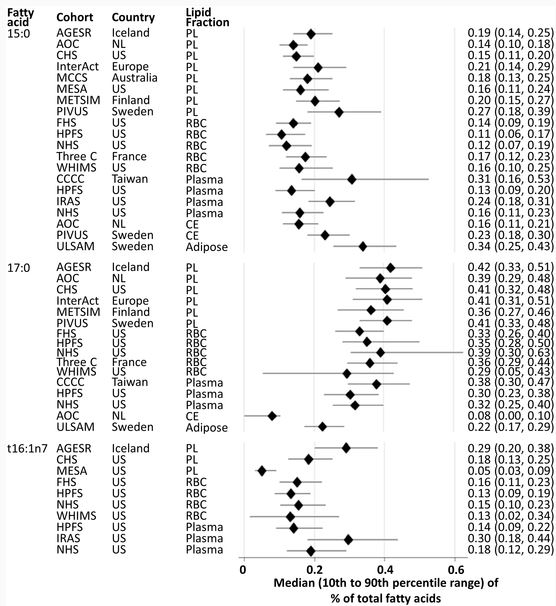A meta-analysis that pooled the findings from 16 prospective cohort studies in PLOS Medicine included data more than 60,000 adults over 20 years as part of the Fatty Acids and Outcomes Research Consortium (FORCE). The reason is simple; in countries where dairy is a cultural heritage and an economic force, dairy is associated with a lower incidence of type 2 diabetes, whereas groups opposed to dairy produce epidemiology papers stating dairy is either irrelevant or harmful. Yogurt and cheese manufacturers are happy to benefit from papers showing their products help limit saturated fat consumption or aid the microbiome or whatever the fad of next year will be.
Biomarkers are tell-tale molecules in the body that can be measured accurately and consistently, and so may act as indicators of dietary consumption. Adding to the daisy chain of inference is that concentrations in body tissue of certain types of fat have been correlated with consumption of fat rich dairy foods, both in self-reported studies and in intervention studies where participants eat a controlled diet. Such biomarkers of dairy fat offer a complementary approach, alongside self-reporting of food consumption, to investigate associations of dairy fat consumption with type 2 diabetes in large populations.

The researchers examined specific biomarkers of dairy fat consumption from a total of 63,682 adults from 16 multi-national studies that are part of the FORCE Consortium. The participants were all free from type 2 diabetes when the first samples were taken, and 15,158 of them went on to develop type 2 diabetes over the follow-up period of up to 20 years. In each of the studies, the researchers analyzed the relationships of dairy fat biomarkers with the risk of developing type 2 diabetes.
When all the results of the 16 studies were pooled the researchers found that higher concentrations of dairy-fat biomarkers were associated with lower risk of developing type 2 diabetes. This lower risk was independent of other major risk factors for type 2 diabetes including age, sex, race/ethnicity, socioeconomic status, physical activity and obesity.
For example, if people among the top fifth of the concentrations of dairy-fat markers were compared with people among the bottom fifth of the concentrations, the top-fifth people had an approximately 30% lower risk of type 2 diabetes.
What does it really mean? The U.S. and international bodies remain stuck in claims that non-fat dairy products are healthier and lead to higher calories and that the saturated fat is a high risk. But it was never clear. And this study may not clear it up for entrenched constituents. This meta-analysis involved no original work so they don't know if the dairy was milk, yogurt, or cheese. It also was overwhelmingly caucasians, which is going to be of limited value in developing countries where more dairy might be a good source of low cost nutrition.





Comments